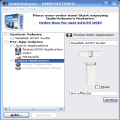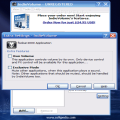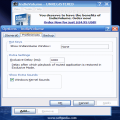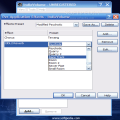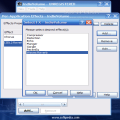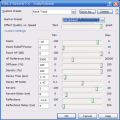When was the last time you gave a thought to volume control? The feature is so trivial that no one ever imagines that it can be improved and extended to more than a simple button that turns the audio up and down. In Vista this has been awarded the necessary attention and the Mixer accessible from Volume icon in system tray offers per application control so that you can turn down a notch the sounds of Internet Explorer or Yahoo Messenger but keep a clear sound on Winamp or, better yet, Foobar.
It does not sound like much but these are choices XP failed to provide and you needed a third party application in order to do this and few were the possibilities to control the sound of each application separately, especially if you wanted more than a simple up and down slider.
IndieVolume is one candidate for the job as it is designed as a "supplement to Windows Volume Control" and allows every application to have the volume configured individually. As many good things do not come cheap, IndieVolume has a price tag that reads $24.95 and a trial period limited to seven days (plenty of time to make yourself a proper idea on the application and its functionality).
The interface is not one of the greatest available and acts just as a location for all the options available in the software. In fact the looks are not great at all since I could not see the entire application screen as you probably have seen in the pictures below. This, however, does not diminish its functionality but only adds a visual inconvenience.
You have to know from the start that IndieVolume automatically integrates in startup (that is if you do not have another app to prevent the action) without any warning so that it can supply its services from the moment you start your computer.
The interface is split into two sections, one containing applications running on your computer and inactive ones as well as system volumes available and one for making the desired settings for each of the selected types of volume or applications. This second window is the most interesting one as it permits per-application volume configuration along with applying sound effects and enforcing a few extra options.
This application's flexibility extends to permitting the user to make a list of programs whose sound should be controlled via IndieVolume. Thus you can add new elements to the list of active applications as well as to the one listing closed apps.
For each program in either list you can select the audio device carrying the sound as well as customize sound balance, volume level or apply a sound effect from a list of over 60 alternatives (ranging from Alley, Car Stereo, Underwater, Padded Cell, or Living Room to Guitar Flanger, Hangar, Grunge, Dizzy, Drugged or CD Audio-Disco). Extra settings that come in IndieVolume are also per-application and allow the user to preserve the application's own volume (balance and volume control bar will be greyed out in this case leaving you with device and FX control) or enforce exclusive mode that mutes all other programs on the list of IndieVolume while it is playing a sound.
To give you an example, if Foobar is in Exclusive Mode, it will not matter if Winamp is running and playing something as well or any other application on IndieVolume's list. Only Foobar will be heard and all the rest will be muted until Foobar takes a break.
As for the way it works, it handles very well audio players like Foobar, Winamp or Windows Media Player but there are some programs, like Metacafe that remained unaffected. Other than this, exclusive mode worked like a charm and each time I started playing music with an application with this feature enabled all other apps would be silenced almost on the spot. The great thing is that pausing the exclusive mode enhanced programs would turn all the others on, so basically it has to come sound out of it in order to make all other programs listen.
There was some trouble, though, when testing the effects IndieVolume makes available, but only if the audio player was not restarted or the running song stopped, and only in Foobar. Using Winamp for the testing everything turned out to work beautifully and with no glitches. However, I wish the transition from one effect to another would be automatic.
Regarding the effects, IndieVolume makes available a wide variety of settings to customize it to best suit your needs. You should know though that all the settings in this section are more suitable for advanced users rather than newbies.
For each effect you have a list of side-effects to be applied so that the result turns into a beautiful sound wave. Depending on the effect you choose in the list, you get to select Chorus, I3DL2 Reverb, Distortion, Flanger, Compressor, Distortion, Gargle, ParamEQ and WaveReverb presets. The presets in their turn can be customized every way possible by tweaking sound parameters like wetness, depth, frequency, waveform, diffusion, density, decay time, reflections, edge, PostEQ Bandwidth, etc. Of course, you are supposed to have the required equipment in order to perceive various sound alterations you make.
All in all the application turns out to be more than a simple per-application volume controller and more of a great tool for tweaking the sound according to the application you run. IndieVolume offers great flexibility although it is not yet a full-fledged application and still has loose ends.
The Good
Extremely easy to use, IndieVolume can be managed to control the sound for each application individually and customize it to your own liking.
Users can play with the balance, enable exclusive mode (when one application plays a sound all the others listen) and make any sound tweaking you need and more.
All settings can be saved to a BIN file and restored with absolutely no problem.
The Bad
There are still issues with the way IndieVolume affects each application and the way it applies effects in some programs, but with a little effort it'll get there.
The interface needs a touch or two in order to make all the buttons visible.
The Truth
The idea of having per-application volume control is great, regardless of the operating system, but implementing it into an easy to use, comprehensive application is where the trouble appears. IndieVolume is a work in progress and still has some shape up to do in order to be able to apply the same treatment to all applications. Winamp and Windows Media Player were the programs it best worked with and we had the less trouble during the testing. With other apps it either did not respond at all or there were some glitches.
The greatest problem when running IndieVolume is not with the application itself but with the hardware used for the sound. Given the great amount of sound effects and presets as well as the customization offered for each of them you sure need some quality audio line to perceive the details.
You have 7 days to test the IndieVolume and decide for yourselves if it is worth the $24.95 it is evaluated by the developer at.
Here are some snapshots of the application in action:
 14 DAY TRIAL //
14 DAY TRIAL // 